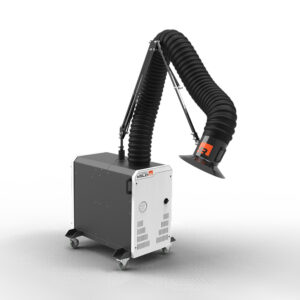Laser Welding
Fume Extractors

What are laser welding fumes?
Laser welding fumes are a complex mixture of metals metallic oxides, silicates and fluorides. Fumes are formed when a metal is heated above its boiling point and its vapours condense into ultrafine particles (solid particulates). Welding fumes generally contain particles the materials being welded. Make sure you remove other coatings like plastics, paints, rubbers, greases, and oils as these may increase the risk fires and/or create other unwanted toxic gases.
For example, fumes from laser welding mild steel contain mostly iron with small amounts of additive metals (chromium, nickel, manganese, molybdenum, vanadium, titanium, cobalt, copper etc.).
Stainless steels can have larger amounts of chromium, including hexavalent chromium, or nickel in the fume and lesser amounts of iron.
Nickel alloys have much more nickel in the fume and very little iron.
Contributions to the fumes can come from coatings on metal being welded. Some ingredients in coatings can have toxic effects. These ingredients include: Zinc on galvanized steel (vaporizes to produce zinc oxide fume, cadmium plating, and chromates. These also form ultrafine particles.
Using the right filter for laser welding fumes.
The individual particles are virtually invisible to the naked eye but can usually be seen as fumes or smoke in high concentrations. Respirable dust particles can penetrate deep into the lungs and increase health risks. However, high-quality, performance-tested HEPA filters can remove respirable dust from the air, therefore making the air safe to breathe. FIltrabox uses high-performance HEPA filters with an impressive tested efficiency of 99.999% @ 0.3 microns. This means that it removes 99.999% of the most aerodynamically penetrating particles, known to be 0.3 microns, while smaller and larger particles are even more effectively captured, resulting in extremely clean air, free of respirable dust.
Relative Particle Size Table.

Is Weld-R Suitable for Laser Welding Fume Extraction?
Filtrabox laser fume extractors are used in many different laser engraving, cutting, and marking applications. They are trusted by a wide spectrum of users, from major manufacturing tech companies to small home businesses worldwide.
Laser welding is a new application coming to the forefront of manufacturing. Filtrabox has developed a laser welding-specific fume extractor to protect people and the environment better. Introducing the Weld-R:
Weld-R focuses on three main objectives: Efficient removal of ultrafine particles, greater maneuverability of the extraction arm and maximum airflow.
Laser welders produce ultrafine particulate matter in the form of fumes. Weld-R comes standard with our highest quality H14 Hepa filter and F9 prefilter – the same used in our popular line of laser fume extractors. The prefilter protects the HEPA at a submicron level while the critical HEPA filter ensures that air is clean with an efficiency of 99.999% @ 0.3 micron.
Too often, the extraction arms are stiff and lack freedom of movement. The welder wastes time struggling to reposition the arm to optimize fume capture. This slows down productivity. Laser welding is a much faster process than traditional welding (Mig, Tig, Arc), which means that the arm’s maneuverability is now even more important. Weld-R’s lightweight arm and extra hood-rotator articulation allows the welding professional to make transitions faster, more precisely and with less effort.
Many other arm manufacturers choose to reduce weight and cost by using smaller diameter ducting (6” diameter or smaller). This comes with a penalty. Airflow is severely restricted by the small diameter ducting – reducing air velocity. When capturing fumes, air velocity or capture velocity is extremely important. If you don’t have sufficient capture velocity, the hood won’t extract the fumes from any practical distance, rendering it almost useless or at best, very frustrating to use. We’ve designed the Weld-R arm to be extremely lightweight, yet without sacrificing airflow. The Weld-R features a huge, class leading 8” diameter duct and an arm design that doesn’t put any structure or support elements within the airflow path. This minimizes air restriction and maxmizes airflow for a larger capture zone.
Frequently Asked Questions
Your Title Goes Here
Your content goes here. Edit or remove this text inline or in the module Content settings. You can also style every aspect of this content in the module Design settings and even apply custom CSS to this text in the module Advanced settings.
What are laser welding fumes?
Laser welding fumes are a complex mixture of metals, metallic oxides, silicates, and fluorides. These fumes are produced when a metal is heated above its boiling point, and its vapors condense into ultrafine particles. The composition of these fumes can vary depending on the materials being welded and any coatings present on those materials. For example, mild steel fumes will contain mainly iron and small amounts of other metals like chromium, nickel, and manganese.
Why are laser welding fumes dangerous?
Laser welding fumes can be hazardous because they consist of respirable dust particles that can penetrate deep into the lungs, increasing health risks. Certain metals and additives, such as hexavalent chromium or cadmium plating, can be particularly toxic. These fumes can also contain dangerous elements from coatings on the metal being welded, such as zinc or chromates, which can have additional toxic effects.
What types of filters are best suited for laser welding fume extraction?
Filtrabox recommends using high-performance HEPA filters with a tested efficiency of 99.999% at 0.3 microns. These filters are extremely effective in capturing respirable dust particles, making the air safe to breathe.
What is the Weld-R, and how is it suitable for laser welding fume extraction?
Weld-R is a laser welding-specific fume extractor developed by Filtrabox. It focuses on three main objectives: efficient removal of ultrafine particles, greater maneuverability of the extraction arm, and maximum airflow. The Weld-R comes standard with an H14 Hepa filter and an F9 prefilter, providing an air cleanliness efficiency of 99.999% at 0.3 microns.
How important is the maneuverability of the extraction arm?
Maneuverability is extremely important, especially for laser welding, which is faster than traditional welding techniques. Weld-R’s lightweight arm and extra hood-rotator articulation allow welding professionals to adjust the arm quickly and precisely, boosting productivity.
How does the diameter of the ducting affect fume extraction?
The diameter of the ducting is crucial for maintaining effective airflow. A smaller diameter restricts airflow, reducing air velocity and capture zone. Weld-R features an 8-inch diameter duct, allowing maximum airflow and a larger capture zone, making the fume extraction process more efficient.
What is capture velocity, and why is it important?
Capture velocity is the speed of air at the hood opening. This overcomes opposing air currents and captures dust to flow into the hood. A higher capture velocity ensures that fumes are effectively removed from the work area. If the capture velocity is too low, the extraction arm may fail to capture the fumes effectively, making it less useful or even frustrating to use.
Can the WELD-R fume extractor be used in other laser applications other than welding?
What materials other than the base material contribute to the toxic effects of welding fumes?
Coatings on the metal being welded, such as zinc on galvanized steel, cadmium plating, and chromates, can vaporize and produce toxic fumes. These ultrafine particles can have harmful effects on health if inhaled. Oils, rust inhibitors, paints, and plastic coatings can also create toxic fumes. These types of coatings must be removed before welding.
What sets WELD-R's HEPA filters apart from other filters on the market?
WELD-R uses high-quality, performance-tested HEPA filters with an efficiency of 99.999% at 0.3 microns. The HEPA media is sealed into rigid box-type aluminum cases, which protect the media from distortion and damage resulting in extremely reliable clean air, free of respirable dust. Other welding extractors use cylindrical filters which are prone to damage. In addition, most welding extractors are not equipped with HEPA filters. The WELD-R comes standard with our high-efficiency HEPA pre-installed and ready to extract – straight out of the box.



